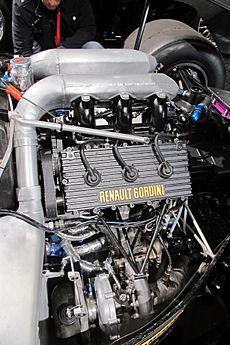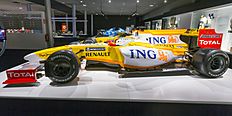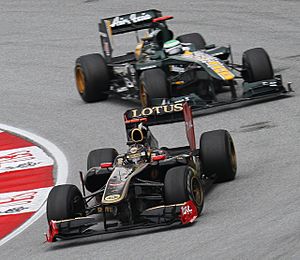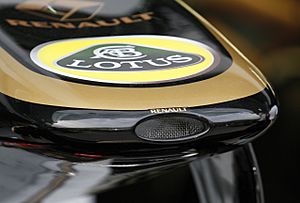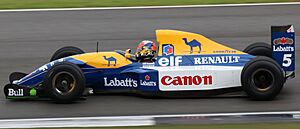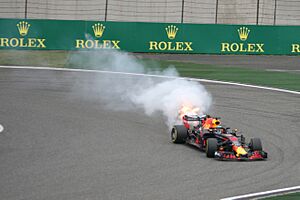Renault in Formula One facts for kids
 |
|
| Full name | Renault Formula 1 Team |
|---|---|
| Base | Viry-Châtillon, Essonne, France (1977–1985) Enstone, Oxfordshire, England, UK (2002–2011, 2016–2020) |
| Noted staff | Bernard Dudot Jean Sage Patrick Faure Bob Bell Éric Boullier Alain Dassas Alan Permane James Allison Flavio Briatore Mike Gascoyne John Iley Steve Nielsen Pat Symonds Dino Toso Dirk de Beer Frédéric Vasseur Rob White Cyril Abiteboul Nick Chester Pat Fry |
| Noted drivers | |
| Previous name | Benetton Formula (1986–2001) Lotus F1 Team (2012–2015) |
| Next name | Alpine F1 Team |
| Formula One World Championship career | |
| First entry | 1977 British Grand Prix |
| Last entry | 2020 Abu Dhabi Grand Prix |
| Races entered | 403 (400 starts) |
| Engines | Renault |
| Constructors' Championships |
2 (2005, 2006) |
| Drivers' Championships |
2 (2005, 2006) |
| Race victories | 35 |
| Podiums | 103 |
| Points | 1777 |
| Pole positions | 51 |
| Fastest laps | 33 |
| Formula One World Championship career | |
|---|---|
| First entry | 1977 British Grand Prix |
| Last entry | 2025 Singapore Grand Prix |
| Races entered | 660 (657 starts) |
| Chassis | Renault, Lotus (1983–1986), Ligier, Tyrrell, Williams, Benetton, Red Bull, Lotus (2011), Lotus (2012–2014), Caterham, Toro Rosso, McLaren, Alpine |
| Constructors' Championships | 12 (1992, 1993, 1994, 1995, 1996, 1997, 2005, 2006, 2010, 2011, 2012, 2013) |
| Drivers' Championships |
11 (1992, 1993, 1995, 1996, 1997, 2005, 2006, 2010, 2011, 2012, 2013) |
| Race victories | 168 |
| Podiums | 459 |
| Points | 7746.5 |
| Pole positions | 213 |
| Fastest laps | 176 |
Renault, a car company from France, has been a big part of Formula One racing since 1977. They have been involved in two main ways: owning their own racing team and making engines for other teams.
In 1977, Renault joined Formula One as a team, bringing in the first turbo engine. This was a big change for the sport. By 1983, they also started selling their engines to other teams. Even though the Renault team won some races, they stopped racing as a full team at the end of 1985. However, their engines were still used by other teams until 1986.
Renault came back to Formula One in 1989, focusing on making engines. They were very successful, winning many championships with teams like Williams and Benetton between 1992 and 1997. They stopped their official engine support after 1997, but their engines were still used by other teams for a few more years.
In 2000, Renault bought the Enstone-based Benetton Formula team. They became an engine maker again in 2001. In 2002, the team was renamed Renault. This team then won both the drivers' and constructors' championships in 2005 and 2006.
By 2011, Renault sold its shares in the Enstone team. They continued to make engines for other teams, winning four more championships with Red Bull Racing between 2010 and 2013.
The company bought the Enstone team again in 2016 and renamed it Renault. The team did not win any races in the next five seasons. In 2021, it was renamed Alpine, with Renault still providing the engines.
As a team owner, Renault has won two championships for teams and two for drivers. As an engine maker, they have won 12 team championships and 11 driver championships. They have won over 160 races as an engine supplier, making them one of the most successful engine makers in Formula One history.
Contents
Renault as a Racing Team (1977–1985)
Early Years: The Turbo Revolution (1977–1978)
Renault's first step into Formula One was through their Renault Sport division. They joined the last five races of the 1977 season with Jean-Pierre Jabouille as their driver. Their car, the Renault RS01, was famous for its 1.5-litre turbocharged engine. This was the first regular turbo engine in Formula One.
In the beginning, the car was not very reliable. It often broke down and was even nicknamed the "Yellow Teapot." Despite its power, it struggled to finish races. Their first race was the 1977 British Grand Prix, but the car retired early. They missed some races to improve the car.
In the 1977 Dutch Grand Prix, Jabouille qualified well, but the car's suspension failed. Reliability issues continued in other races. The team even failed to qualify for the 1977 Canadian Grand Prix.
The next year, 1978, was also tough with many engine problems. However, towards the end of the year, the team showed signs of improvement. The RS01 qualified third twice. It finally finished a race at Watkins Glen, earning the team its first Formula One points with a fourth-place finish.
First Win and Becoming a Frontrunner (1979–1983)
In 1979, René Arnoux joined Jabouille, and the team grew to two cars. They still had some struggles, but Jabouille got a pole position in South Africa. Later that season, both drivers got a new car, the RS10, which used a special "ground-effect" design.
At the 1979 French Grand Prix, Renault made history. Jabouille won the race, making the RS10 the first turbocharged car to win a Grand Prix. Arnoux also had an exciting battle for second place. Arnoux then finished second in the next two races, showing their success was not just luck.
In 1980, Arnoux won two races in a row in Brazil and South Africa. These races were at high altitudes, where the Renault cars performed very well. Jabouille also won a race in Austria. Sadly, Jabouille had a bad crash at the 1980 Canadian Grand Prix, which ended his racing career.
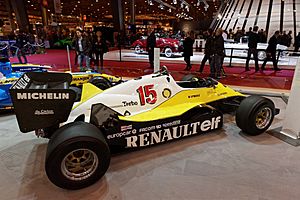
Alain Prost joined the team in 1981. In his three years with Renault, Prost became a Formula One star. The Renault team was one of the best, finishing third in the team championships twice and second once. Prost won nine races with the team, and Arnoux won two more in 1982.
Arnoux left for Ferrari after 1982 and was replaced by Eddie Cheever. In 1983, Renault and Prost were very close to winning the drivers' championship. However, they were just beaten by Nelson Piquet in the last race in South Africa.
End of the First Era (1984–1985)
After the 1983 season, Prost left the team. Renault hired Patrick Tambay and Derek Warwick. The team was not as strong in 1984 and 1985 as other teams had improved their turbo engines.
In 1985, Renault made another F1 first. They used a third car in the 1985 German Grand Prix that had the first-ever live in-car camera for TV viewers. The car, driven by François Hesnault, retired early. By 1985, Renault faced money problems. They decided to stop being a full racing team and only supply engines for the 1986 season, before leaving F1 entirely at the end of that year.
Renault F1 Team: The Enstone Era (2002–2011)
Return to F1 and Early Success (2000–2004)
On March 16, 2000, Renault bought the Benetton Formula team. This team had started as Toleman Motorsport in 1981 and moved to Enstone, England, in 1992. Renault kept the Benetton name for the 2000 and 2001 seasons. The Renault name returned as an engine brand in 2001. In 2002, the team was officially renamed Renault F1.
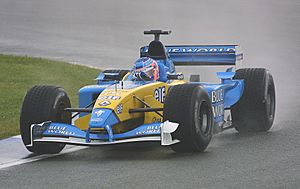
In 2002, Renault F1 raced with Jarno Trulli and Jenson Button. They scored 23 points. Renault also changed its racing license to French.
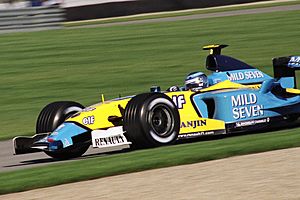
For 2003, Button was replaced by Fernando Alonso, who had been a test driver. Alonso won the 2003 Hungarian Grand Prix, which was Renault's first Grand Prix win since 1983. Renault tried new engine designs during this time, like a special 10-cylinder engine in 2003. However, it was not reliable enough, so they went back to more traditional designs.
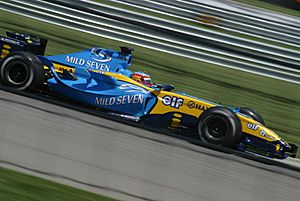
In 2004, the team aimed for second place in the team championship. Trulli won the 2004 Monaco Grand Prix. However, his relationship with the team boss, Flavio Briatore, became difficult. Trulli left the team early and was replaced by Jacques Villeneuve for the last three races. The team finished third in the championship.
Back-to-Back Championships (2005–2006)

Giancarlo Fisichella joined Renault for the 2005 season. He won the first race in Australia. Fernando Alonso then won the next three races, building a big lead in the drivers' championship. Renault also led the team championship.
Alonso secured the drivers' title at the 2005 Brazilian Grand Prix, becoming the youngest driver to do so at the time. Renault then won the team championship at the 2005 Chinese Grand Prix. This was Renault's first team title as a manufacturer. It also ended Ferrari's six-year winning streak.
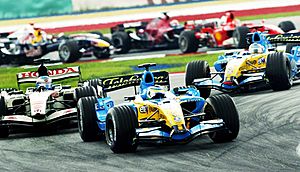
Alonso and Fisichella stayed for 2006. Alonso won the first race in Bahrain and the Australian Grand Prix. Fisichella won in Malaysia, giving Renault a one-two finish. Alonso continued to win races, including his home Grand Prix in Spain and the Monaco Grand Prix.
The team celebrated its 200th Grand Prix at Silverstone, which Alonso won. Alonso also won the 2006 Canadian Grand Prix.
During 2006, a special system called a "mass damper" was banned by the FIA. Renault had developed this system, and it helped their car's performance. Even though the system was banned, Renault still managed to win the team championship in 2006 at the 2006 Brazilian Grand Prix.
Challenges and Changes (2007–2009)

For 2007, Fisichella and Heikki Kovalainen were the drivers. Renault's performance was not as strong as in previous years. Fisichella finished fifth in Australia, but Kovalainen struggled. The team's pace improved later in the season.
In November 2007, the FIA accused Renault F1 of having secret technical information from McLaren. Renault was found to have the information but was not punished.
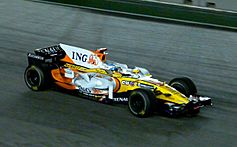
Fernando Alonso returned to Renault for 2008, alongside Nelson Piquet Jr.. The team's performance was mixed at the start of the season. Piquet Jr. struggled, but Alonso showed flashes of speed.
At the 2008 German Grand Prix, Piquet Jr. got Renault's first podium of the year, finishing second. Alonso then won the 2008 Singapore Grand Prix, which was Renault's first win since 2006. This was also the first Formula One race ever held at night under floodlights. Alonso won again at the 2008 Japanese Grand Prix. By the end of 2008, the Renault car was much stronger.

In 2009, Renault hoped to challenge for championships, but this did not happen. Alonso scored some points, but the car was not fast enough. Alonso got a pole position in Hungary, but had to retire from the race. Piquet Jr. was replaced by Romain Grosjean later in the season.
During 2009, there were serious questions about a crash involving Nelson Piquet Jr. at the 2008 Singapore Grand Prix. This crash happened just before his teammate Fernando Alonso won the race. After an investigation, the FIA found that Renault had broken the rules. As a result, team principal Flavio Briatore and engineer Pat Symonds left the team. Renault was given a suspended ban from Formula One, meaning they would be kicked out if a similar event happened before the end of 2011.
Selling the Team and Stepping Back (2010–2011)
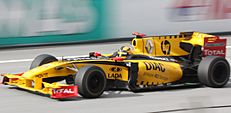
In 2010, Renault sold most of its shares in the team to a company called Genii Capital. Renault kept a 25% share and continued to supply engines. Robert Kubica joined as Alonso's replacement, and Vitaly Petrov became his teammate, making him Russia's first Formula One driver.
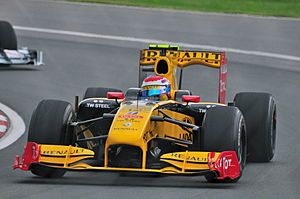
Kubica had a strong season, getting a second-place finish in Australia and a third-place in Monaco. Petrov also scored his first points in Formula One. The team finished fifth in the constructors' championship.
On November 5, 2010, Renault announced they would reduce their involvement in 2011, becoming only an engine supplier. The team was renamed Lotus Renault GP for 2011, under a sponsorship deal with Lotus Cars. Renault continued to provide engines and support. The team also changed its racing license to British.
In February 2011, Robert Kubica was badly injured in a rally accident. Nick Heidfeld was signed to replace him. Petrov got his first and only podium in Formula One, finishing third in Australia. Heidfeld also finished third in Malaysia. The team's performance faded later in the season. Heidfeld was replaced by Bruno Senna for some races.
For the 2012 season, the team was renamed Lotus F1 Team.
Renault Sport Formula One Team (2016–2020)
Return as a Full Team (2016)
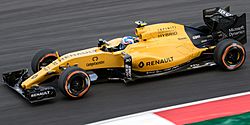
On September 28, 2015, Renault announced they planned to buy back the Lotus F1 Team (the same team they had owned before). On December 3, 2015, Renault confirmed they had bought the team and would race as Renault Sport Formula One Team in 2016.
For 2016, Kevin Magnussen and Jolyon Palmer were the drivers. The team finished ninth in the championship with 8 points.
Improving Performance (2017–2018)

In 2017, Nico Hülkenberg joined the team. Jolyon Palmer stayed for part of the season but was replaced by Carlos Sainz Jr. from the 2017 United States Grand Prix onwards. Sainz had a good start, finishing seventh in his first race with the team. Renault finished sixth in the championship with 57 points.
Hülkenberg and Sainz continued to drive for Renault in 2018. The team had its best result in the constructors' championship, finishing fourth with 122 points.
Ricciardo Era and Final Year (2019–2020)

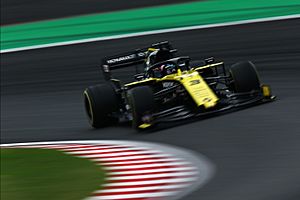
For 2019, Daniel Ricciardo joined the team to race alongside Hülkenberg. The team faced reliability problems and struggled with their car's design. They finished fifth in the constructors' championship. At the end of the season, Renault made changes to their car design team.
Esteban Ocon joined Renault for the 2020 season, replacing Hülkenberg. The start of the season was delayed due to the COVID-19 pandemic. In Belgium, Renault had a strong race, finishing fourth and fifth. At the 2020 Eifel Grand Prix, Ricciardo scored a third-place finish, which was the team's first podium since 2011. Ricciardo got another third-place finish in Italy. Ocon also finished second at the 2020 Sakhir Grand Prix, his first podium and Renault's third of the season.
Ricciardo finished fifth in the drivers' championship, and Ocon finished twelfth. Renault finished fifth in the constructors' championship with 181 points.
After the 2020 season, the Renault team was rebranded as Alpine for 2021.
Renault as an Engine Supplier (1983–2025)
Early Turbo Engines (1983–1986)
Renault started making engines at their factory in France in 1976. They created the first turbocharged engine in Formula One, a 1.5-litre V6. At first, they only supplied engines to their own team. In 1983, they began selling engines to other teams, starting with Team Lotus.
The Lotus team became more competitive with Renault engines, with drivers like Nigel Mansell and Elio de Angelis getting podium finishes. In 1984, Renault also started supplying engines to the Ligier team. In 1985, Ayrton Senna joined Lotus. He won three races with the fast Renault-powered Lotus car, but reliability issues prevented a championship challenge. The Tyrrell team also started using Renault engines in 1985.
After the 1985 season, the Renault racing team left F1, but they continued to supply engines to Ligier, Tyrrell, and Lotus. In 1986, they introduced new engine technology. Renault Sport stopped its engine program at the end of 1986.
Success with Naturally Aspirated Engines (1989–2013)
Renault returned as an engine supplier in 1989 after turbocharged engines were banned. They partnered with the Williams team. Renault created the first V10 engine with special pneumatic valves. The Williams-Renault combination won its first race in 1989.
By 1992, with advanced car technology and better engines, the Williams-Renault car was a championship winner. Driver Nigel Mansell won the drivers' title. Williams won the championship again in 1993 with Alain Prost as driver.

In 1994, Williams driver Ayrton Senna died in a crash. His teammate Damon Hill became the team leader. Williams won the constructors' championship that year.
In 1995, engine rules changed, and Renault adapted its engine. The Benetton team started using Renault engines. Their driver, Michael Schumacher, won the drivers' title, and Benetton won the constructors' title. Williams won the next two seasons, with Damon Hill winning in 1996 and Jacques Villeneuve in 1997.
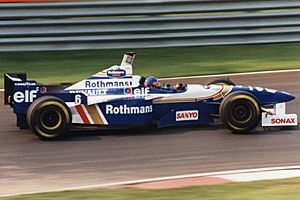
Renault left F1 again at the end of 1997. However, their engines were still used by other teams under different names like Mecachrome and Supertec until 2000.
Engine Success with Red Bull (2007–2013)
After buying the Benetton team, Renault did not supply engines to other teams until 2007. They then signed a deal with Red Bull Racing. Red Bull was a midfield team at first.
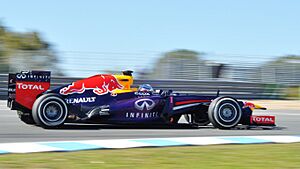
In 2009, Red Bull won their first race with Renault engines. Drivers Sebastian Vettel and Mark Webber won five more races, and the team finished second in the constructors' championship. In 2010, Vettel and Red Bull won both the drivers' and constructors' championships. This was the ninth title for a Renault engine.
In 2010, when Renault sold their racing team, their engine operations became a separate company called Renault Sport F1. They continued to supply engines to Red Bull and their former team (now Lotus Renault GP). Red Bull won both titles again in 2011 and 2012. In 2012, Williams also started using Renault engines again. Red Bull and Sebastian Vettel won their fourth straight titles in 2013.
Hybrid Era Challenges and End of Supply (2014–2025)
Renault developed a new 1.6-litre V6 turbocharged hybrid engine for the 2014 season. This engine was named Energy F1. Red Bull and Caterham used Renault engines. Scuderia Toro Rosso also signed a deal to use Renault engines.
During early tests in 2014, the new Renault engines had problems with reliability and speed. Renault worked to fix these issues throughout the season.
In 2015, Red Bull tried to end their contract with Renault due to performance issues but later agreed to continue. In 2016, Red Bull's Renault engines were rebranded as TAG Heuer. Toro Rosso switched back to Ferrari engines. Red Bull renewed their engine contract with Renault for two more years, still using the TAG Heuer name.
In September 2017, McLaren announced they would use Renault engines from 2018 to 2020. Toro Rosso then switched to Honda engines. In June 2018, Red Bull also announced they would use Honda engines from 2019.
As McLaren switched to Mercedes engines for 2021, Renault became a single-team engine supplier again. The Enstone-based team was rebranded to Alpine from 2021, with Renault still providing the engines.
Despite a win for Alpine driver Esteban Ocon at the 2021 Hungarian Grand Prix, the Renault engine continued to struggle compared to its rivals. Alpine stated in 2023 that their car was slower mainly because of the Renault engine.
Due to the lack of success and reliability problems since 2014, Renault announced on September 29, 2024, that they would stop making their own F1 engines after the 2025 season. The CEO of Groupe Renault said it would be cheaper to buy engines from another company. Alpine will use Mercedes engines from 2026 onwards.
After the 2025 Japanese Grand Prix, reports showed that Alpine's Renault engines were particularly slow on the straight parts of the track. This showed why Renault decided to stop making their own engines.
Formula One Engine Supplier Results (Excludes Factory Team)
| Constructor | Season(s) | Total wins | First win | Last win | Pole positions | First pole | Last pole |
|---|---|---|---|---|---|---|---|
| 1983–1986 | 5 | 1985 Portuguese Grand Prix | 1986 Detroit Grand Prix | 19 | 1983 European Grand Prix | 1986 Mexican Grand Prix | |
| 1984–1986, 1992–1994 | 0 | – | – | 0 | – | – | |
| 1985–1986 | 0 | – | – | 0 | – | – | |
| 1989–1997, 2012–2013 | 64 | 1989 Canadian Grand Prix | 2012 Spanish Grand Prix | 80 | 1989 Hungarian Grand Prix | 2012 Spanish Grand Prix | |
| 1995–1997, 2001 | 12 | 1995 Brazilian Grand Prix | 1997 German Grand Prix | 6 | 1995 San Marino Grand Prix | 1997 Italian Grand Prix | |
| 2007–2015 | 50 | 2009 Chinese Grand Prix | 2014 Belgian Grand Prix | 53 | 2009 Chinese Grand Prix | 2013 Brazilian Grand Prix | |
| 2011 | 0 | – | – | 0 | – | – | |
| 2012–2014 | 2 | 2012 Abu Dhabi Grand Prix | 2013 Australian Grand Prix | 0 | – | – | |
| 2012–2014 | 0 | – | – | 0 | – | – | |
| 2014–2015 | 0 | – | – | 0 | – | – | |
| 2018–2020 | 0 | – | – | 0 | – | – | |
| 2021–2025 | 1 | 2021 Hungarian Grand Prix | 2021 Hungarian Grand Prix | 0 | – | – | |
| Total | 1983–2025 | 134 | 1985 Portuguese Grand Prix | 2021 Hungarian Grand Prix | 158 | 1983 European Grand Prix | 2013 Brazilian Grand Prix |
Renault/Alpine Young Driver Program
When Renault returned to Formula One, they started a program for young drivers. This program aims to find and train future Formula One champions. The academy was renamed Alpine Academy in 2021 when the Renault F1 Team became the Alpine F1 Team.
Renault Formula One Results
As a team, Renault has achieved the following:
- Won 2 out of 25 team championships (8%).
- Won 2 out of 25 drivers' championships (8%).
- Won 35 out of 403 races (8.7%).
| Formula One results | ||||||||
|---|---|---|---|---|---|---|---|---|
| (Bold indicates championships won.) | ||||||||
| Year | Name | Car | Engine | Tyres | No. | Drivers | Points | WCC |
| 1977 | RS01 | EF1 1.5 V6 t | M | 15. | 0 | NC | ||
| 1978 | RS01 | EF1 1.5 V6 t | M | 15. | 3 | 12th | ||
| 1979 | RS01 RS10 |
EF1 1.5 V6 t | M | 15. 16. |
26 | 6th | ||
| 1980 | RE20 | EF1 1.5 V6 t | M | 15. 16. |
38 | 4th | ||
| 1981 | RE20B RE30 |
EF1 1.5 V6 t | M | 15. 16. |
54 | 3rd | ||
| 1982 | RE30B | EF1 1.5 V6 t | M | 15. 16. |
62 | 3rd | ||
| 1983 | RE30C RE40 |
EF1 1.5 V6 t | M | 15. 16. |
79 | 2nd | ||
| 1984 | RE50 | EF4 1.5 V6 t | M | 15. 16. 33. |
34 | 5th | ||
| 1985 | RE60 RE60B |
EF4B 1.5 V6 t EF15 1.5 V6 t |
G | 14. 15. 16. |
16 | 7th | ||
| 1986–2001: Renault did not compete as a constructor | ||||||||
| 2002 | R202 | RS22 3.0 V10 | M | 14. 15. |
23 | 4th | ||
| 2003 | R23 R23B |
RS23 3.0 V10 | M | 7. 8. |
88 | 4th | ||
| 2004 | R24 | RS24 3.0 V10 | M | 7. 7. 8. |
105 | 3rd | ||
| 2005 | R25 | RS25 3.0 V10 | M | 5. 6. |
191 | 1st | ||
| 2006 | R26 | RS26 2.4 V8 | M | 1. 2. |
206 | 1st | ||
| 2007 | R27 | RS27 2.4 V8 | B | 3. 4. |
51 | 3rd | ||
| 2008 | R28 | RS27 2.4 V8 | B | 5. 6. |
80 | 4th | ||
| 2009 | R29 | RS27 2.4 V8 | B | 7. 8. 8. |
26 | 8th | ||
| 2010 | R30 | RS27-2010 2.4 V8 | B | 11. 12. |
163 | 5th | ||
| 2011 | R31 | RS27-2011 2.4 V8 | P | 9. 9. 10. |
73 | 5th | ||
| 2012–2015: Renault did not compete as a constructor | ||||||||
| 2016 | R.S.16 | R.E.16 1.6 V6 t | P | 20. 30. |
8 | 9th | ||
| 2017 | R.S.17 | R.E.17 1.6 V6 t | P | 27. 30. 55. |
57 | 6th | ||
| 2018 | R.S.18 | R.E.18 1.6 V6 t | P | 27. 55. |
122 | 4th | ||
| 2019 | R.S.19 | E-Tech 19 1.6 V6 t | P | 3. 27. |
91 | 5th | ||
| 2020 | R.S.20 | E-Tech 20 1.6 V6 t | P | 3. 31. |
181 | 5th | ||
Esports
Complete F1 Esports Series Results
| Year | Chassis | Drivers | 1 | 2 | 3 | 4 | 5 | 6 | 7 | 8 | 9 | 10 | 11 | 12 | Points | WCC |
|---|---|---|---|---|---|---|---|---|---|---|---|---|---|---|---|---|
| 2018 | Renault R.S.18 | AUS | CHN | AZE | FRA | GBR | BEL | GER | SIN | USA | ABU | 23 | 9th | |||
| 5 | 14 | 8 | 15 | 17 | 13 | |||||||||||
| 18 | 11 | 15 | 16 | 11 | 6 | 15 | ||||||||||
| 14 | 15 | 16 | 14 | 10 | 12 | 13 | ||||||||||
| 2019 | Renault R.S.19 | BHR | CHN | AZE | CAN | RBR | GBR | GER | BEL | ITA | JPN | USA | BRA | 172 | 4th | |
| 2 | 5 | 14 | 3 | 3 | 10 | 1 | 3 | 8 | 6 | 4 | 12 | |||||
| 11 | 18 | 10 | 1 | 4 | 13 | 12 | 14 | |||||||||
| 8 | 10 | 14 | 7 | |||||||||||||
| 2020 | Renault R.S.20 | BHR | VIE | CHN | NED | CAN | RBR | GBR | BEL | ITA | JPN | MEX | BRA | 136 | 3rd | |
| 5 | 2 | 15 | 5 | 4 | 5 | 1 | 9 | 10 | 2 | 13 | 1 | |||||
| 19 | 8 | 10 | 13 | 12 | 17 | 18 | 12 | 17 | 16 | 18 | ||||||
| Ret |
See also
 In Spanish: Renault en Fórmula 1 para niños
In Spanish: Renault en Fórmula 1 para niños


